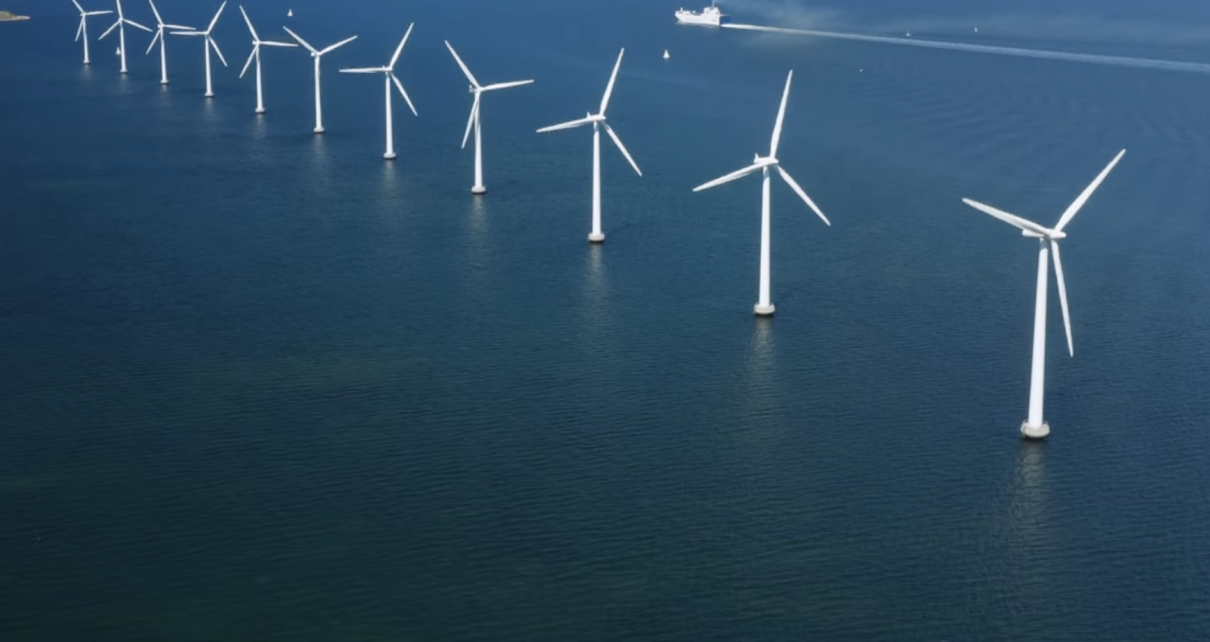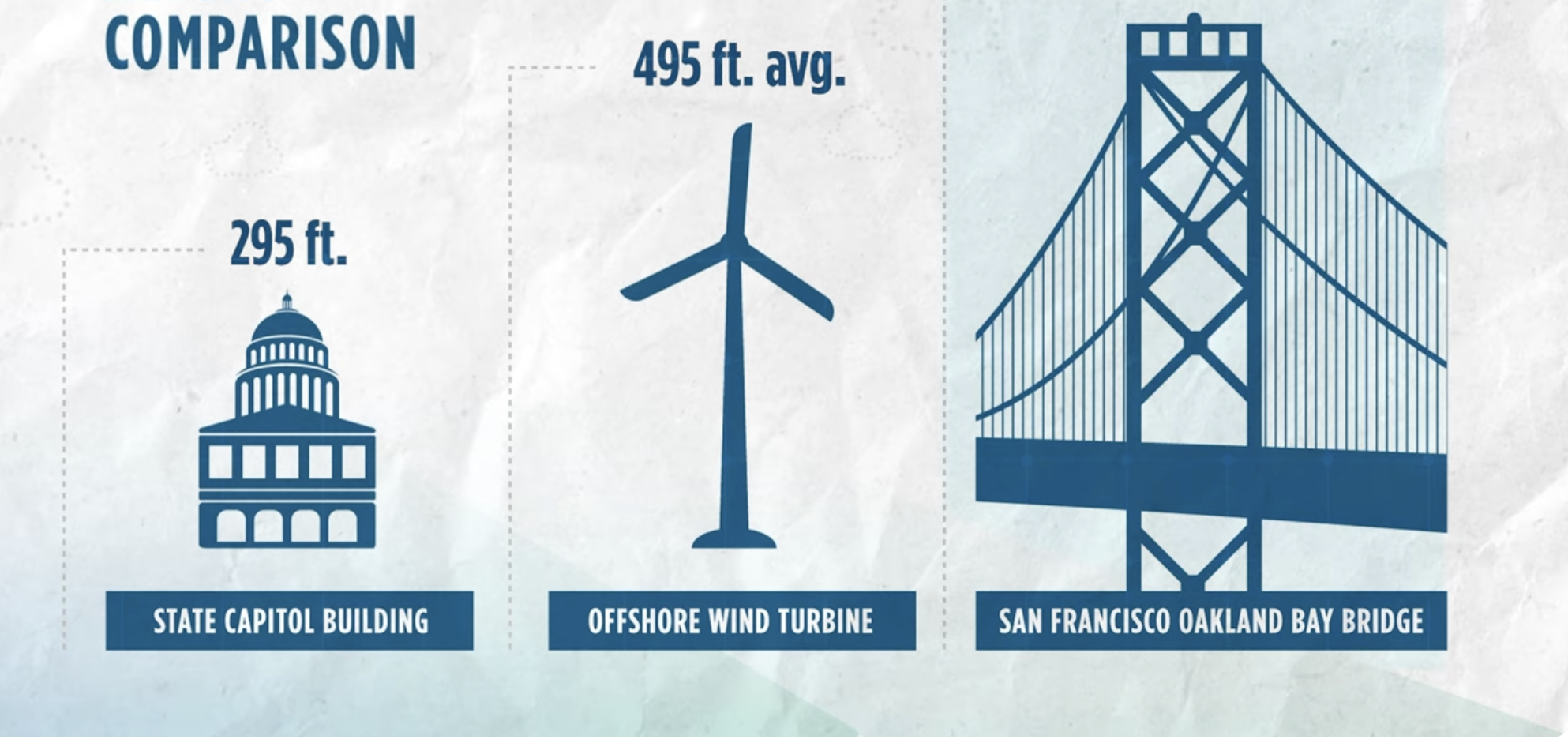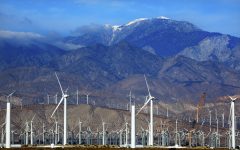
Offshore Wind farm. (Photo: Energy.ca.gov)
Ringside View: Offshore Wind is a Financial and Environmental Catastrophe
Hasn’t anyone calculated what 25 gigawatts of offshore wind capacity is going to look like?
By Edward Ring, November 19, 2023 2:30 am

It’s about time Californians of all ideological persuasions wake up and stop what is possibly the most economically wasteful and environmentally destructive project in American history: the utility scale adoption of offshore wind energy.
The California Legislature intends to despoil our coastline and coastal waters with floating wind turbines, 20+ miles offshore, tethered to the sea floor 4,000 feet beneath the waves. Along with tethering cables, high voltage wires will descend from each of these noisy, 1,000 foot tall leviathans, but we’re to assume none of this will disrupt the migrations of our treasured Cetaceans and other marine and avian life, not the electric fields emanating from hundreds (thousands?) of 20+ mile long live power lines laid onto the ocean floor, nor from the construction, the maintenance, or the new ports, ships, and submersibles.
This article from Politico, published September 1, seems to celebrate the passage of AB 1373, which authorizes the California Dept. of Water Resources to go “shopping for offshore wind.” It includes this quote, “’Central procurement makes offshore wind possible,’ said Martin Goff, California project director for the Norwegian developer Equinor.” And massive subsidies, perhaps?
One month earlier, in August, Equinor pulled out of the Trollvind project in the North Sea because of unforeseen challenges including “technology availability, time constraints, and rising costs that made the project commercially unsustainable.” Also in August, Equinor sought “a 54 percent increase for the price of power produced at three planned U.S. wind farms” off the coast of New York. In the face of a likely denial, Equinor announced it could cancel U.S. offshore wind projects. In November 2021, Equinor abandoned a 1.4 GW floating wind farm off the shores of Ireland.
With these financial failures behind them, Equinor is betting California can deliver a level of subsidies that were denied elsewhere, killing those projects. They’re probably right.
Last month Cal Matters published a reasonably balanced report describing local reaction to planned offshore wind developments in San Luis Obispo and Humboldt counties. But while the article quoted a paid proponent of the project dismissing skeptics as NIMBYs, it didn’t investigate the possibility of wind industry contributions flowing into the political campaigns of local elected officials, along with the bank accounts of supportive nonprofits, tribes, and media properties. Hundreds of billions in California taxpayer funded subsidies are at stake.
The Cal Matters article reported the California Energy Commission’s goal to achieve 25 gigawatts of offshore wind capacity. Hasn’t anyone calculated what that’s going to look like? Here is a best case scenario.
Even if these machines had a 40 percent yield, which is a realistic estimate of how frequently there will be enough wind to turn the rotors, and even if each machine had a capacity of 10 megawatts, 2,500 of them would be required to generate 10 gigawatts of baseload power.
Floating wind turbines with a capacity of 10 megawatts have barely been prototyped and have no long-term record of durability. As designed, each one is 1,000 feet from the waterline to the tip of the blade, and also require a commensurate flotation vessel and counterweight below the waterline. From tip to tip, they are longer than a U.S. Navy supercarrier.

Because these machines only generate power intermittently, generating 10 baseload gigawatts would require proportionate battery storage, along with thousands of miles of new undersea and land based high voltage lines. All this would only deliver 10 percent of the 100 gigawatt generating capacity Californians are going to need if the state legislature succeeds in forcing our residential and transportation sectors to go all-electric.
To get an idea of the environmental impact of offshore wind turbines, this article from the California Policy Center provides useful links to additional reports on the environmental destruction wrought by wind energy, both onshore and offshore. Wind turbines aren’t just Condor Cuisinarts. Along with raptors, condors, and other magnificent endangered birds, they kill bats and insects – their blades are at the altitude insect species migrate.
Offshore, it’s worse. According to a recent study sponsored by a New England commercial fishing association, electromagnetic fields from undersea cables produce birth deformities in marine life and produce magnetic fields that disrupt the orientation abilities of some fish. Their low frequency operational noise disrupts sounds made by fish for mating, spawning, and navigating. The turbines “increase sea surface temperatures and alter upper-ocean hydrodynamics in ways scientists do not yet understand,” and “whip up sea sediment and generate highly turbid wakes that are 30-150 meters wide and several kilometers in length, having a major impact on primary production by phytoplankton which are the base of marine food chains.”
Support for offshore wind by environmentalist organizations is inexplicable. Apparently, just say the magic words “climate crisis,” and anything goes.
In California, environmentalist safeguards, always a good idea, have been taken to extremes. On the California coast, hyper-regulation is the norm. Natural gas fueled generating plants situated on the California coast are being decommissioned. Diablo Canyon nuclear power station is one regulatory hiccough away from its demise. A desalination plant that would have made Orange County completely independent of imported water was struck down last year by the coastal commission. As for offshore rigs harvesting from some of the biggest reservoirs of oil and gas in the world? Shut them down!
But if you want to stick thousands of floating wind turbines offshore, at stupefying cost, California’s Byzantine bureaucracy and captive taxpayers are here to help.

- Ringside: The Case for Oil Drilling in California - April 30, 2024
- Ringside: The Potential of Waste-to-Energy in California - April 17, 2024
- Ringside: How Much Water Will $30 Billion Buy? - April 10, 2024





Climate Fetish — An urban myth is a fictional tale or conspiracy theory that circulates widely, is told and retold and presumed true by mere repetition. Urban myths are spread and illuminated in mass media, and become part of popular culture. Urban myths circulate from no singular source and can survive as fearmongering news items. Myth-making eco-propagandists have become mainstream news media assets. Urban myths can be dangerous propaganda that causes civic alarm and paranoia often for nefarious political advantage. Examples are the global Y2K internet collapse, white privilege, Russian collusion, World War III and endless doomsday scenarios. For over a half century, environmentalists have menaced us with fear-mongering scenarios of man-made ecological apocalypse. The environmental movement is the most densely-organized movement in human history. There are over 15,000 environmental nonprofits in the U.S. Having run out of green campaign grievances for their tax-exempt fundraising, radical eco-groups have come up with the most fantastic, intractable and theoretical problem of all – controlling dynamic, natural global climate variabilities (atmospheric thermodynamic radiative forcing). In scapegoating climate change for every inexplicable natural phenomenon and natural disaster, green-government tyranny would subvert capitalism itself with “climate austerity.” Partisan green-government regulations inflate the costs of goods, services, activities, food, and energies.
Amen
Is it a bad ideal, yes, will it cost billions the state doesn’t have, yes, sounds like another high-speed rail. The Newsom and Pelosi family retirement fund. But wait they will get reelected again no matter how bad the state gets!
nuclear power had the promise of cheap energy. Once the projects were underwasy, the regulation started and continued until they were uneconomical. it will be that way with wind. The big projects on the east coast have already been abandoned. the same company that walked away on the east coast wants to try it again in California.
That tells me they worked at a profit until the subsidy ran out and then walked away
I recall reading that part of the Siemens turbine reliability issue was that as the turbines grow larger, with larger capacity, they are reaching the limits of both aerodynamic and generator speed engineering. Super large turbines are proving less reliable. for example, see https://www.science.org/doi/10.1126/science.aau2027. In addition, studies have been done that show that the area required for such wind (and solar) fields have been underestimated by a factor of at least 10. There are no cost-free answers to the energy question, just trade-offs. There are the trade-offs between economies powered by wind/solar and those powered by fossil/nuclear and then within the environmental movement there are trade-offs between greenhouse gas/climate change and direct environmental degradation as outlined in this article. The problem is that there are too many unknowns. But the government is always in the mode of “don’t just stand there, do something” (see COVID), when sometimes, waiting or letting the market take the lead is the best course of action.
Steve Bannon: We Must Investigate Jan 6 Select Committee for the “Brazen Criminality” of What They Did – Video
https://commoncts.blogspot.com/2023/11/steve-bannon-we-must-investigate-jan-6.html
So why not talk about how rooftop solar with residential battery storage eliminates the need for these massive centralized power generation systems? Complain complain complain without discussions of solutions is just fear mongering. What I keep seeing is more money spent on centralized generation and centralized storage when distributed generation and distributed storage costs less and reduces infrastructure loading.
With vehicle and storage battery recycling ramping up the 20 year lifespan of the batteries means a less expensive battery replacement will be cost effective and environmentally acceptable.
There are thousands of offshore wind turbines up and running and connected to the grid in countries all over the world. And they continue to build more because they work. The U.S. has 7 in total up and running. We have become the nation of can’t. Other countries can, but America can’t. Propaganda from the fossil fuel industry, not in my backyard, and misinformed environmental challenges have stalled development in the U.S. for decades. European countries had 3,200 offshore turbines running 8 years ago.
Thank you Edward. I was halfway through writing another article nearly exactly as this one you wrote. I think yours is better. Great job!
Green has never been about saving the planet or any other positive goal. Green has always been a Grift with the added benefit of destroying nature. Wind power kills birds by the millions and offshore wind apparently is wiping out whales (remember “Save the Whales”?). Wind power is also deforesting the planet as ‘Greens” clear cut (remember when that was bad?) to make room for wind turbines that kill birds, generate obnoxious noise and ultimately fail leaving waste that no one knows how to recycle. Solar and lithium batteries are destroying the environment due to all the mining and deserts are being destroyed to make room for solar panels.
The left has always been about death whether it be abortion, man made diseases, wars or “green”.
Norway did a thorough study too, the govt just chose to ignore it.
https://www.google.com/url?sa=t&source=web&rct=j&opi=89978449&url=https://www.noordzeeloket.nl/publish/pages/204320/current-state-of-knowledge-electromagnetic-fields.pdf&ved=2ahUKEwjR74jv6NOCAxUgkokEHcweB8YQFnoECBoQAQ&usg=AOvVaw2IZbOYy1FfkXHkrd64MKPz
Much like they ignored Australia’s study on seismic surveys killing plankton
https://www.google.com/url?sa=t&source=web&rct=j&opi=89978449&url=https://www.imas.utas.edu.au/news/news-items/new-research-reveals-impact-of-seismic-surveys-on-zooplankton&ved=2ahUKEwicgvSj6tOCAxUspokEHSRACWoQFnoECBoQAQ&usg=AOvVaw0JPsoWOfHwF01vuTUC5mMg
While this is a good article as it’s coverage that’s desperately needed so people can have an, actually, informed opinion it hardly scratches the surface. What about PFAS contamination from the blades degrading? What about turbines increasing vertical mixing of air layers? What about how NOAA scientists themselves stating offshore wind will pose a threat to whales and mammals even after construction until decommissioning due to noise emissions? What about who will pay for decommissioning? (it’s us)
And to anyone talking about “big oil propaganda” what do you think equinor makes almost all their money on? Or shell? Open up your minds and do some reading.